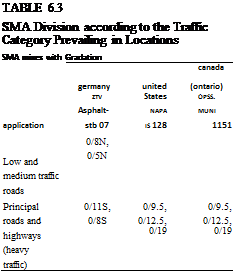Traffic Loading and Location
Coarse-graded mixtures make stronger skeletons. That is why the majority of requirements for SMA contain a noticeable tendency toward increasing the maximum particle size in a mixture in conjunction with an increase in the traffic loading. When selecting a mixture, both the strengths and weaknesses of an accepted solution
should be considered; mixtures with larger maximum particle size (let us suppose greater than 10 mm) are characterized by higher rut resistance but lower noise reduction ability and poorer skid resistance. Therefore, when at all possible, SMA 0/11 is being gradually abandoned for SMA 0/8.
In Germany, SMA 0/8S and 0/11S have been used on the most heavily trafficked roads while on lesser trafficked roads mixtures without an S marking are used. The guidelines from 2001 to 2007 (ZTV Asphalt-StB 01 and ZTV Asphalt-StB 07, respectively) have differentiated mixtures according to traffic, with the understanding that mixtures with the same maximum aggregate size but intended for various traffic loadings differ in the shape of the gradation limits. German SMA aggregate mixes of the S type differ from the lower traffic SMAs in that they have the following:
• Lower filler contents
• Lowered gradation limit curves
• No non manufactured (natural) sand
As a result, German SMA mixtures of the “S” type should be coarser and, at the same time, less closed. This is logical since there should be more voids in a heavily trafficked course (refer also to the Dutch method in Chapter 7).

In many countries, as in Germany, different SMA gradation curves have been specified depending on the traffic category (traffic loading), as shown in Table 6.3.
|
slovakia |
Poland |
slovenia sist |
Australia |
|
klaz |
WT-2 |
1038- |
NAs 2EcI |
|
1/2008 |
2008 |
5:2008 |
2004 |
|
— |
0/5, |
0/4, 0/8, |
0/7, 0/10 |
|
0/8 |
0/11 |
|
0/8, |
0/8, |
0/8, 0/11 0/10, 0/14 |
|
0/11, |
0/11 |
|
|
0/16 |






Leave a reply